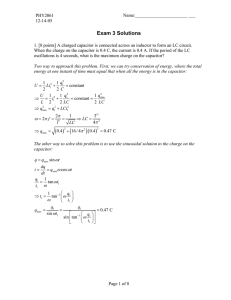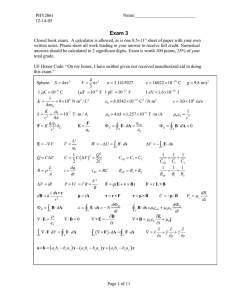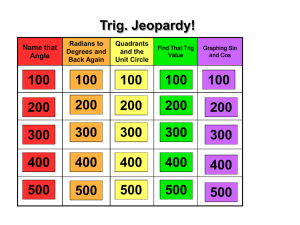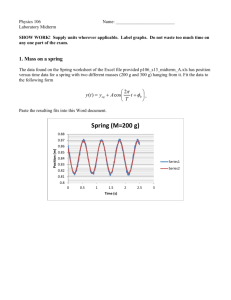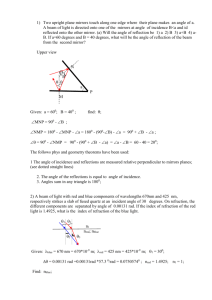Exam3_soln_f05
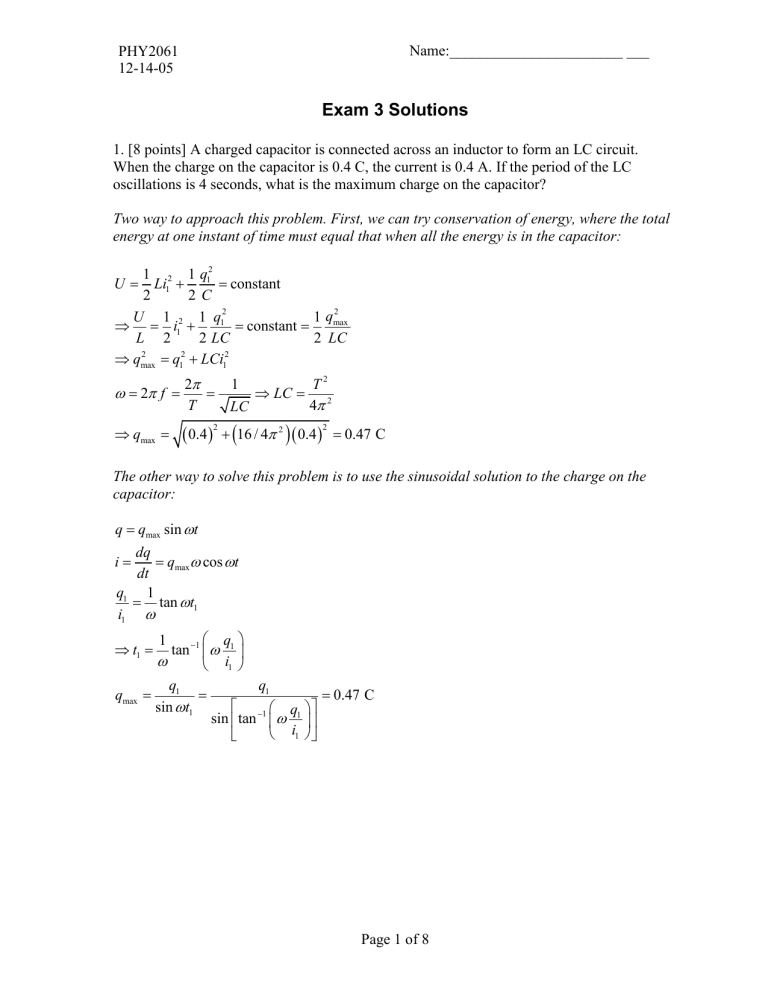
PHY2061
12-14-05
Name:_______________________ ___
Exam 3 Solutions
1. [8 points] A charged capacitor is connected across an inductor to form an LC circuit.
When the charge on the capacitor is 0.4 C, the current is 0.4 A. If the period of the LC oscillations is 4 seconds, what is the maximum charge on the capacitor?
Two way to approach this problem. First, we can try conservation of energy, where the total energy at one instant of time must equal that when all the energy is in the capacitor:
U
1
2
Li
1
2
1
2 q
1
2
C
constant
2 q max q
1
2
U
L
1
2 i
1
2
1
2 LC
q
1
2
LCi
1
2
2
f
2
T
q max
2
constant
1
2
2 q max
LC
1
LC
LC
T
2
4
2
16 / 4
2
2
0.47 C
The other way to solve this problem is to use the sinusoidal solution to the charge on the capacitor: q
q max sin
t i
dq
dt q max
cos
t q
1 i
1
1
tan
t
1
1
tan
1
q
1 i
1
q max
sin q
1
t
1
q
1
sin tan
1
q
1 i
1
0.47 C
Page 1 of 8
PHY2061
12-14-05
Name:_______________________ ___
2. For a certain driven series RLC circuit, the inductance L = 80 mH, the resistance R = 40
, and the capacitance C = 0.4
F. The generator provides a source of EMF that varies sinusoidally with a cyclic frequency of 1000 Hz.
(a) [6 points] If the peak voltage from the generator is 10 V, what is the peak current?
m
Z
R 2
L
1
C
2
1000
L
502.7
1
C
398
m
10 V
40 2
2
2
0.089 A
(b) [6 points] What is the phase constant between the generator voltage and the current?
Does the current lead or lag the generator voltage?
By convention:
m sin
t
i m sin
That is, for positive phase angle
, the current lags.
Now tan
X
L
X
C
R
L
1
C
R
104.8
40
1.2 (69 )
Since positive, current lags.
Page 2 of 8
PHY2061
12-14-05
Name:_______________________ ___
3.
[8 points] A uniform electric field points in the z -direction with a value given by the expression: E
Z
, where a = 1800 V/m and b = 700 V / (m s). The electric field is confined to a circular region in the x-y plane with radius r = 5 m. What is the magnitude of the magnetic field at a point along the circumference of the circle at the time t = 2 s?
Use Maxwell’s Law of Induction:
C
B
d s
d
E
2
rB
0 0 r
2 dt
E
t br
1.94 10
14
T
2 c
2
4.
The electric field of an electromagnetic wave is given by
E
y
N
C sin
6
7.20 10 m
1
x
8 t
(a) [6 points] What is the cyclic frequency of the wave (in Hz)?
The electric field has the form
E
E m sin
where
kx
t
6
8
2
f
15
1.08 10 Hz
(b) [6 points] Write down an equivalent expression for the magnetic field, including the polarization direction and the peak magnitude.
Note that the electric field is traveling in the
ˆ
The electric field polarization is in the
ˆ
direction.
direction.
Thus, the magnetic field must be polarized in the
ˆ
direction so that S
1
0 points in the direction of motion for the wave.
The amplitude of the magnetic field is related to that of the electric field by:
E m
c
B m
E B
Thus,
B
z
6
6
1
x
8 t
Page 3 of 8
PHY2061
12-14-05
Name:_______________________ ___
5.
[8 points] What is the current density (direction and magnitude) in a region of space where the magnetic field is given by B
B x
0
and there is no electric field present?
Differential form of Maxwell’s Law of induction and Faraday’s Law:
× B
0
E
t
0 j
Since E =0, we have
× B
0 j
B y
x
0 j (all other terms zero)
B
0
0
Note that B
B x
x
B y
y
B z
z
0 as needed
6.
[8 points] A beam of unpolarized light is passed though a series of 3 polaroid filters.
The first and third filters have their polarization directions 90
apart. The second one has its polarization direction oriented 30
relative to the first. What fraction of the intensity of the initially unpolarized light is transmitted after passing through the 3 filters?
The intensity of unpolarized light that passes through one polaroid filter, no matter what the angle, is always cut in half (the average of cos
2
is ½):
I
1
1
2
I
0
.
Once the light passes through that filter, its polarization is defined by the direction of the filter. The intensity of light passing through the second filter is then given by:
I
2
I
1 cos
2
2 1
I
1 cos
2
, since it is the relative angle between the two filter sheets that matters. The intensity of light coming from the third sheet is thus:
I
3
I
2 cos
2
3 2
I
2 cos
2
1
I
0 cos
2
2
3
I
0
0.094
I
0
2 32
Note that there is nothing special about the 90° angle difference between the first and third filters that would make the intensity 0. It would only happen if the middle sheet was aligned with either the first or third sheet.
Page 4 of 8
PHY2061
12-14-05
Name:_______________________ ___
7.
[8 points] Consider the propagation of white light through an optical fiber. The core of the fiber is made of a material that exhibits chromatic dispersion and has an index of refraction that varies from 1.455 for red light to 1.460 for blue light. What is the spread in the arrival time between red and blue light at the end of 10 km of fiber?
Assume that the light travels in a straight line in the fiber. v red
c n red v blue
c n blue t
L v t t blue
t red
c
L n blue
n red
4
10 m
8
3 10 m/s
0.005
1
6
s
7
1.67 10 s
8.
[8 points] An isotropic point source of light is located 4 m below the surface of a pool of water with index of refraction n = 1.33. The surface of the water is absolutely smooth. Find the radius of the largest circle on the pool’s surface through which light coming directly from the source can emerge into the air above.
First find the critical angle for total internal reflection from within the wate. This will define the maximum circle on the water: n air sin
air n water sin
crit
crit
sin
1
1 n water
48.8
Now the angle of incidence with respect to the normal to the water surface is the same as the angle from the normal to the outermost radius of the circle of light. tan
crit
r
4 m
4.56 m
Page 5 of 8
PHY2061
12-14-05
Name:_______________________ ___
9.
A lens has a shape as shown in the figure. For a light ray traveling from the left, the font face is flat and the rear face is convex with a radius of curvature of 0.8 m. The glass that makes the lens has an index of refraction of n = 1.5.
(a) [6 points] What is the focal length of the lens?
Note that a light ray facing a convex surface means that the surface is considered to have a positive radius of curvature. f f
1
n
1
1.6 m
1
1 r r
1 2
1
1
0.8
1
1.6
A negative focal length implies a diverging lens.
(b) [6 points] If an object is placed 0.8 m to the left of the lens, what is the distance to the image from the lens and is the image real or virtual?
1 1 1 f p i
1
2
1
1.6
1.6
i i
1.6
3
0.53 m
The negative image distance implies a virtual image.
Page 6 of 8
PHY2061
12-14-05
Name:_______________________ ___
10.
[8 points] The reflection of perpendicularly incident white light by a soap film in air has an interference maximum at a wavelength of 600 nm and a minimum at 525 nm, with no minimum between 600 and 525 nm. If n = 1.43 for the film, what is the film thickness, assumed uniform?
For constructive interference,
2 t
m
1
2
max
where
max
max n
For destructive interference,
2 t
m
1
min
where
min
min n
Solving for t and m gives:
2 t
max
1
2
2 t
min
2 t
1
min
1
1
max
1
2
4
1
min
1
1
max
4 n
1
min
1
1
max
734 nm
Plugging into an earlier equation yields m = 3.
Page 7 of 8
PHY2061
12-14-05
Name:_______________________ ___
11.
[8 points] In a Young’s double-slit experiment, light of wavelength 550 nm illuminates 2 slits that are separated by 0.15 cm. What is the separation between adjacent bright fringes on a screen 5 m from the slits? sin
m
m
d y m
d
m
y m
0.0018 m = 1.8 mm
Page 8 of 8
